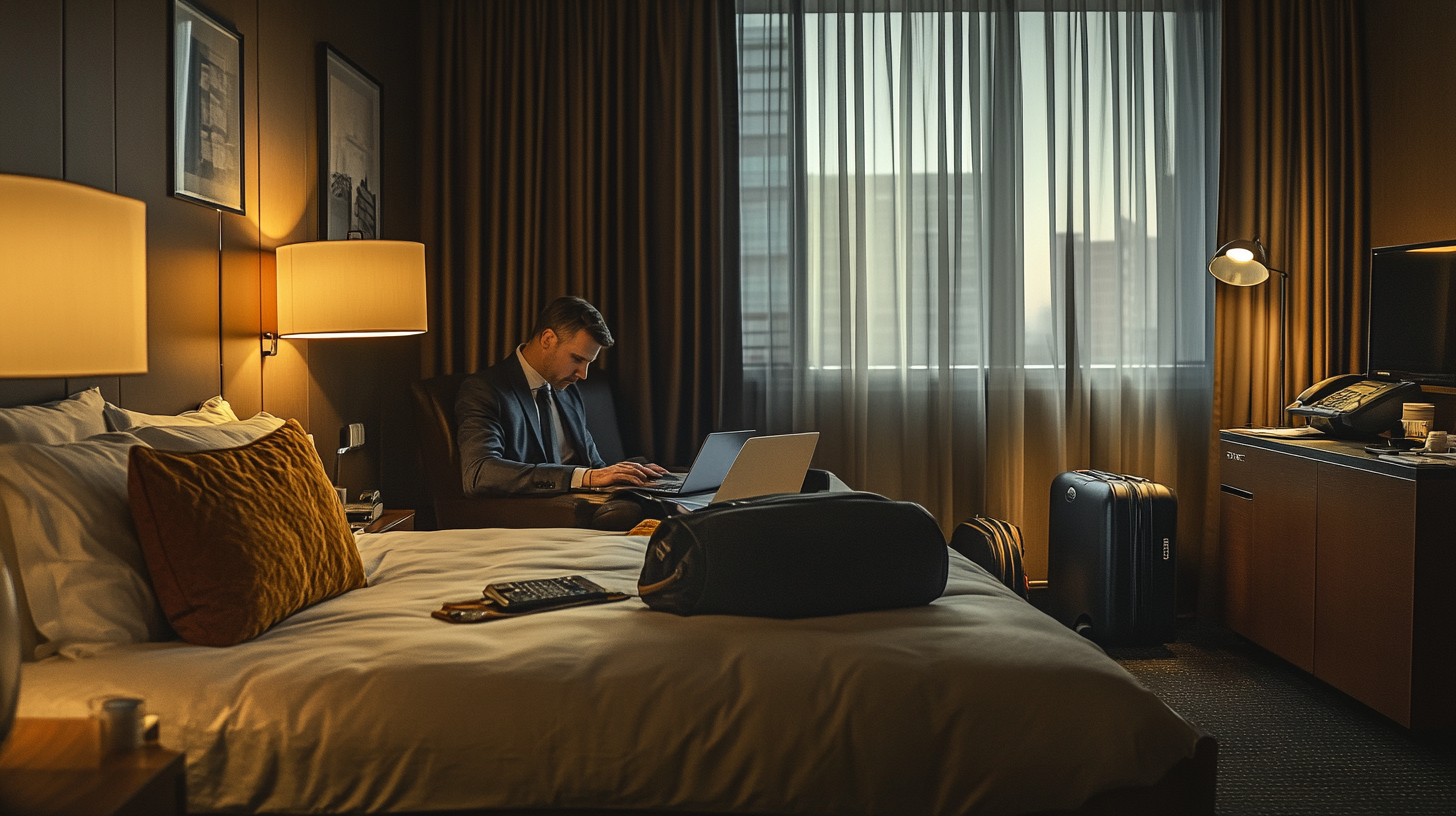How Long Do Business Trips Typically Last?

I’ve always believed business travel is more than a simple flight in and out—it’s a vital part of forming real connections in our increasingly digital world. Over the years, I’ve read countless traveler accounts describing everything from tight, full-day agendas to leisurely multi-week visits, and it’s clear there’s no one-size-fits-all model. Industry data shows that business travel bounced back significantly from the downturn a few years ago, growing 14% in 2021 and 32% in 2022, and by 2025, it’s on track to potentially reach $2 trillion in global spending. This ongoing rebound highlights the importance of flexible, well-planned trips—no matter their length.
Short Business Trips (1–7 Days)

In my own experience, short business trips are a whirlwind of opportunities—you fly in, shake hands, share ideas, and fly out. According to current industry data, frequent flyers average nearly seven business trips a year, with millennials edging that total a bit higher. A typical international trip these days runs about 5.82 days, which can feel like just enough time to cover the essentials. Yet I’ve often found that no matter how brief the journey is, it can still hinder personal plans. One traveler confided that although they’d handled five- to seven-day jaunts with ease for years, they felt unexpectedly homesick when a work trip collided with a family birthday. Moments like that remind me to plan ahead, making sure I manage both professional and personal commitments.
I’ve observed that when you’re on a shorter trip, packing efficiently makes life so much easier—especially if you’re zipping from meeting to meeting. I’ll often stash a change of clothes in my carry-on and focus on versatile items that can handle both conference-room formality and casual dinners. A recent study suggests that savvy travelers who plan their itineraries in segments—such as scheduling morning client meetings and afternoon site visits—are the ones who maximize productivity and still carve out time for relaxation. These short but dynamic trips underline the power of careful organization, particularly when deadlines loom.
If you’re new to the idea of short-term travel, one practical strategy is to keep a pre-packed toiletry kit and a digital copy of all essential documents. I’ve met corporate travelers who swear by these simple prep steps because they can accept last-minute assignments without stress. While these truncated trips might leave limited time for sightseeing, they bring the advantage of condensed, high-impact networking that drives projects forward.
Mid-Range Stays (1–3 Weeks)

Whenever I settle into a stay that spans a week or two, I start thinking about how to maintain a work-life rhythm on the road. These mid-range trips often involve a full slate of meetings, site tours, and the occasional conference—your calendar can look like a jigsaw puzzle if you’re not careful. According to industry surveys from earlier this decade, mid-length stays are still a cornerstone of many corporate travel policies, underscoring their importance for on-the-ground tasks like negotiating contracts and checking in on extended projects. I’ve seen employers increasingly encourage travelers to schedule downtime, ensuring that jet lag and stress don’t derail productivity.
In my observation, many travelers take advantage of the so-called “bleisure” trend—tacking a weekend or a few leisure days onto their trip. A recent study, done in partnership with a major hotel brand, revealed that adding a brief vacation onto an existing business journey not only helps combat burnout but also fosters stronger personal ties. After all, it’s far easier to sign a contract when both parties can bond over local cuisine or share a side trip to a nearby attraction. For me, blending business with personal explorations of a new locale strikes the perfect balance—though I always keep one eye on my schedule so I don’t lose track of work commitments.
If you’re planning a mid-range stay, consider your accommodation type carefully. I’ve found that having access to a kitchenette or reliable laundry service can make a world of difference when you’re in town for multiple days. It’s an investment in comfort that repays itself by cutting out extra stress and time spent on mundane chores, letting you focus on what matters—achieving your goals and making lasting connections.
Extended Travel (10–30 Nights)

When a trip stretches into the 10–30 night range, I tend to treat my hotel room or serviced apartment like a second home. These lengthier visits let you dive into the local environment, establish daily rituals, and form more than surface-level client relationships. I’ve read numerous traveler stories pointing out that an extended stay is what truly cements mutual trust—after all, spending multiple weeks in a client’s orbit means you’ll have more casual conversations that can spark innovative ideas. However, you’ve got to pace yourself to avoid burnout.
According to industry data, lodging brands like Locke aparthotels cater specifically to the extended-stay crowd, offering full kitchens and communal workspaces to mimic the comfort of home. This makes such trips less draining, especially when you need to manage consistent laundry schedules or special diets. I’ve found that scheduling a mid-trip break—maybe a quick day trip or a few hours exploring a local market—can breathe new life into a long assignment. It’s also key to keep a close eye on expenses; while extended visits can be more cost-efficient overall, the numbers can creep up if you don’t track them regularly.
Working on-site for several weeks reliably shows your clients and partners that you’re deeply invested in building solutions tailored to their needs. It’s one reason extended trips are favored in fields like engineering, healthcare consulting, or software development, where in-depth oversight is crucial. Just remember to remain flexible—on an extended travel schedule, unexpected changes are common, and the ability to adapt is what sets frequent flyers apart.
Extended Business Travel (30–90 Days)

Once you pass the one-month mark and head toward a three-month commitment, you’re venturing into Extended Business Travel (EBT) territory. Companies are using EBT to manage major projects or rapidly growing local teams. From my perspective, living abroad for such an extended time means truly embedding with local colleagues and discovering subtle nuances in cross-cultural communication. However, it also prompts organizational complexities—immigration, tax obligations, and corporate liability all come into play.
Part of my routine when preparing for an EBT is to map out local requirements in advance—if you need a work visa, you can’t leave that off until the last minute. According to industry experts, the most successful travelers often receive extensive support from their company, including handbooks on cultural norms, housing recommendations, and health insurance coverage details. I’ve noticed that having these resources at your fingertips can alleviate many of the burdens that come with relocating—even temporarily. Remember, a balanced approach to your work and personal time keeps the momentum going and makes it easier to commit fully to the assignment.
For families or significant others at home, a multi-month stay abroad can be tough, so consistent communication matters. Weekly video calls, shared photo streams, or short text updates can mean the difference between feeling disconnected and feeling uplifted. My advice? Stay organized, keep your managers in the loop, and take your downtime just as seriously as your meeting schedule. EBT is an opportunity to forge deeper working relationships—but it’s also a risk if you’re unprepared.
Mastering the Perfect Balance

Whether you’re off on a one-day meet-and-greet or settling in for several months, it’s all about finding your personal equilibrium. I’ve witnessed how consistent budgeting, early flight bookings, and robust visa preparations go a long way in smoothing out rough edges, particularly for extended stays. Digital marketing professionals often remind me that while nothing replaces the spark of in-person collaboration, remote teamwork tools can fill gaps between visits, keeping momentum alive.
What makes these trips truly work is mindful planning—the kind that accounts for security lines, local customs, expense policies, and even your own mental health. For instance, booking a seat with extra legroom might seem frivolous to some, but in my view, small comforts add up to a more productive traveler. Continuous improvements, from expense-tracking apps to streamlined check-in procedures, help you go the distance—figuratively and literally. After all, the purpose of business travel is to get the job done without forgetting the human side of the journey.
Final Thoughts

The more I learn about business travel, the more I’m convinced that every trip is its own unique chapter in a traveler’s story. Whether it’s a jam-packed day trip or a multi-month immersion, each format brings distinct challenges and rewards. Keeping your health and personal obligations in mind can make all the difference, reinforcing the idea that no journey succeeds without a little balance.
If there’s one thing I’ve realized, it’s that packing light, planning early, and giving yourself room to breathe allows you to tap into the full potential of every mile you fly. Studying travel data and hearing real-world accounts has shown me that, with the right strategies, business trips don’t have to be all work and no play. They can boost your professional goals and broaden your horizons—sometimes simultaneously.
Ryder’s Take
From my window seat, I’ve observed that the most rewarding trips, big or small, happen when you embrace both structure and spontaneity. Knowing how to shift gears between official duties and personal exploration can turn a routine client meeting into a memorable milestone. Ultimately, these experiences remind me that flying out of your comfort zone is often where the real growth occurs.
I’m a seat strategist at heart, and if there’s one seat worth claiming, it’s the one that allows you to see not only your destination but the wider perspective of why you’re traveling in the first place.
Seat5A is your passport to a smoother, smarter travel experience—happy flying!






